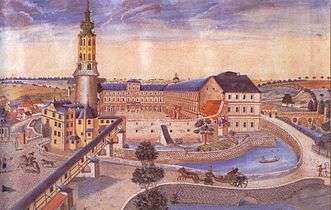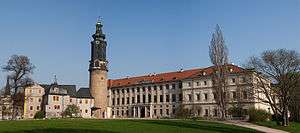Schloss Weimar
| Schloss Weimar | |
|---|---|
|
View of the South wing, the tower, and the oldest part Bastille on the left | |
| Alternative names |
|
| General information | |
| Status | Museum |
| Location | Weimar, Thuringia, Germany |
| Coordinates | 50°58′49″N 11°19′56″E / 50.9803°N 11.3322°ECoordinates: 50°58′49″N 11°19′56″E / 50.9803°N 11.3322°E |
Schloss Weimar is a Schloss (palace) in Weimar, Thuringia, Germany. It is now called Stadtschloss to distinguish it from other palaces in and around Weimar. It was the residence of the dukes of Saxe-Weimar and Eisenach, and has also been called Residenzschloss. Names in English include Palace at Weimar, Grand Ducal Palace, City Palace and City Castle. The building is located at the north end of the town's park along the Ilm river, Park an der Ilm. It forms part of the World Heritage Site "Classical Weimar".
In history, it was often destroyed by fire. The Baroque palace from the 17th century, with the church Schlosskirche where several works by Johann Sebastian Bach were premiered, was replaced by a Neoclassical structure after a fire in 1774. Four rooms were dedicated to the memory of poets who worked in Weimar, Johann Wolfgang von Goethe, Johann Gottfried Herder, Friedrich Schiller and Christoph Martin Wieland. From 1923, the building has housed the Schlossmuseum, a museum with a focus on paintings of the 15th and 16th centuries and works of art related to Weimar, a cultural centre.
History

The building has been developed over the past 500 years. The first building on the site was a medieval moated castle, which was first documented at the end of the 10th century. After a fire in 1424, and again from the mid-16th century, when Weimar became the permanent residence of the dukes, it was remodelled. After another fire in 1618, reconstruction began in 1619 planned by the Italian architect Giovanni Bonalino. The church was completed in 1630,[1][2] where several works by Johann Sebastian Bach were premiered between 1708 and 1717.[3] In the 1650s Johann Moritz Richter was engaged by Wilhelm, Duke of Saxe-Weimar to modify the design to a symmetrical Baroque structure with three wings, open to the south.[1] After Wilhelm's death in 1662, the new building became known as the "Wilhelmsburg"; the chapel was called the "Himmelsburg".
The building was destroyed by fire in 1774. Duke Carl August formed a commission for its reconstruction directed by Johann Wolfgang Goethe.[2] Architects Johann August Arens, Nikolaus Friedrich Thouret and Heinrich Gentz kept the former walls of the east and north wings and created a "classical" interior, especially the staircase and the banqueting hall (Festsaal). Decoration was supplied by sculptor Christian Friedrich Tieck. In 1816, Clemens Wenzeslaus Coudray began plans for the west wing, which was reopened in 1847 with a court chapel. The wing contained the so-called Dichterzimmer (poets' rooms), initiated by Duchess Maria Pavlovna. They commemorate Christoph Martin Wieland, Johann Gottfried Herder, Friedrich Schiller and Goethe. From 1912 to 1914 a south wing was added under Duke Wilhelm Ernst.[1][4]
The Herder Room was restored in 2005, the restoration of the Goethe Room and the Wieland Room was completed in 2014.[5]
 Town and Residenz around 1650
Town and Residenz around 1650 Town and Residenz around 1686
Town and Residenz around 1686 The Wilhelmsburg around 1730
The Wilhelmsburg around 1730 The Bastille around 1905
The Bastille around 1905- Court, seen from the south wing, 2014
- Staircase, 1801
Museum
The building has been used as a museum since 1923. The Schlossmuseum presents exhibitions focused on paintings from 1500 to 1900 related to the history of Weimar. The ground floor holds paintings of the Renaissance, especially works by Lucas Cranach the Elder and Lucas Cranach the Younger, and medieval sacred art, the upper floor displays paintings of Goethe's period in representative rooms, and the top floor contains works of the 19th-century Weimarer Malerschule (Weimar School) and contemporary art.[6]
- Carolingian ivory (9th century)
- Albrecht Dürer: Hans and Felicitas Tucher (1499)
%2C_Schlossmuseum_Weimar.jpg) Lucas Cranach the Elder: Die Früchte der Eifersucht (1527)
Lucas Cranach the Elder: Die Früchte der Eifersucht (1527) Georg Friedrich Kersting: Die Stickerin (1812)
Georg Friedrich Kersting: Die Stickerin (1812)- Auguste Rodin: Das eherne Zeitalter (1875/76)
- Claude Monet: The Cathedral of Rouen (1894)
Since 2008 the Klassik Stiftung Weimar has owned the site with the exception of the Bastille part, owned by the Stiftung Thüringer Schlösser und Gärten.
References
- 1 2 3 "Stadtschloss mit Schlossmuseum" (in German). Klassik Stiftung Weimar. Retrieved 9 June 2014.
- 1 2 "Das Stadtschloss Weimar / The Palace at Weimar" (PDF). Klassik Stiftung Weimar. 2010. Retrieved 9 June 2014.
- ↑ "Computer-Rekonstruktion von J. S. Bachs Weimarer Schlosskirche gelungen" (in German). Kulturinformationszentrum. 30 May 2005. Retrieved 10 June 2014.
- ↑ "City Palace". Weimar. Retrieved 9 June 2014.
- ↑ "Dichterzimmer im Weimarer Schloss fertig saniert" (in German). dpa. 15 May 2014. Retrieved 9 June 2014.
- ↑ "Schlossmuseum Weimar" (in German). Thuringia. Retrieved 9 June 2014.
Bibliography
- Rolf Bothe: Dichter, Fürst und Architekten. Das Weimarer Residenzschloß vom Mittelalter bis zum Anfang des 19. Jahrhunderts. Ostfildern-Ruit 2000.
- Residenzschloss Weimar. 15 Jahre – 15 Millionen Investitionen. Die Grundsanierung in 15 Jahren durch die Stiftung Thüringer Schlösser und Gärten. Imhof-Verlag, Petersberg 2009.
- Christian Hecht: Dichtergedächtnis und fürstliche Repräsentation. Der Westflügel des Weimarer Residenzschlosses. Architektur und Ausstattung. Ostfildern 2000.
- Roswitha Jacobsen (Hrsg.): Residenzschlösser in Thüringen: kulturhistorische Porträts. Quartus-Verlag, Bucha 1998.
- Willi Stubenvoll: Schlösser in Thüringen: Schlösser, Burgen, Gärten, Klöster und historische Anlagen der Stiftung Thüringer Schlösser und Gärten. Verl. Ausbildung + Wissen, Bad Homburg 1997.
- Adolph Doebber: Das Schloss in Weimar : seine Geschichte vom Brande 1774 bis zur Wiederherstellung 1804. Fischer, Jena 1911.
External links
| Wikimedia Commons has media related to Schloss Weimar. |
- Homepage
- Weimar / The Grand Ducal Palace, Ensemble Bastille, city of Weimar Stiftung Thüringer Schlösser und Gärten
- Residenzschloss Weimar weimar.city-map.de (German)
- Schlosskapelle Weimar, virtual tour, a Bauhaus-Uni Weimar project
